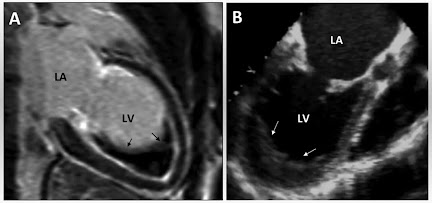HYPERTROPHY OF THE HEART
Definition - Hypertrophy
of the heart is defined as an increase in size and weight of the myocardium. In
which involve predominantly the left or the right or both sides of the heart. It
generally results from increase pressure load while increased volume load
results in hypertrophy with dilatation. It is a compensatory mechanism of the
heart.
Common
causes – (usually causes are
unknown)
- Stretching
of myocardial fibrosis.
- Anoxia
(e.g. in coronary atherosclerosis).
- Certain
hormones (e.g. Catecholamines and pituitary growth hormone).
- Left
ventricular hypertrophy.
Causes of left ventricular
hypertrophy –
- Systemic
hypertension.
- Aortic
stenosis and insufficiency / regurgitation.
- Mitral
insufficiency / regurgitation.
- Coarctation
of the aorta.
- Occlusive
coronary artery disease.
- Congenital
anomalies like septal defects and patent ductus arteriosus.
- Conditions
with increased cardiac output e.g. thyrotoxicosis, anaemia, arteriovenous
fistula.
Causes of right ventricular
hypertrophy –
- Pulmonary
stenosis and regurgitation.
- Tricuspid
regurgitation.
- Mitral
stenosis and regurgitation.
- Chronic
lung diseases (e.g. chronic emphysema, bronchiectasis, pneumoconiosis,
pulmonary vascular disease).
- Hypertrophy
and failure of left ventricle.
Causes of dilatation –
- Valvular
regurgitation.
- Left
to right shunt (e.g. in ventricular septal defect (VSD).
- Conditions
with high cardiac output (e.g. thyrotoxicosis, arteriovenous shunt).
- Myocardial
diseases (e.g. cardiomyopathies, Myocarditis).
- Systemic
hypertension.
Morphological features - Hypertrophy
of myocardium without dilatation called concentric and with dilatation called
eccentric hypertrophy. The weight of the heart is increased above normal
(500 gm). Excessive pericardial fat not indicate true hypertrophy. Thickness of
the left ventricular wall (above 15 mm) is indicates hypertrophy.

Schematic diagram showing transverse section through the ventricles with left ventricular hypertrophy (concentric and eccentric)
GROSSLY -
- In
concentric hypertrophy, the lumen of the chamber is smaller than normal, while
in eccentric hypertrophy the lumen is dilated.
- Papillary
muscles and trabeculae carneae are rounded and enlarged in concentric
hypertrophy, while flattened in eccentric hypertrophy.
MICROSCOPICALLY - There
is increase in size of myocardium. There may be multiple minute foci of
degenerative changes and necrosis in affected myocardium resulting in develop
hypoxia due to inadequate blood supply to increased muscle fibers, while
ventricular hypertrophy is lead to ischaemia.
Similar Posts -
Causes of left ventricular
hypertrophy –
- Systemic hypertension.
- Aortic stenosis and insufficiency / regurgitation.
- Mitral insufficiency / regurgitation.
- Coarctation of the aorta.
- Occlusive coronary artery disease.
- Congenital anomalies like septal defects and patent ductus arteriosus.
- Conditions with increased cardiac output e.g. thyrotoxicosis, anaemia, arteriovenous fistula.
Causes of right ventricular
hypertrophy –
- Pulmonary stenosis and regurgitation.
- Tricuspid regurgitation.
- Mitral stenosis and regurgitation.
- Chronic lung diseases (e.g. chronic emphysema, bronchiectasis, pneumoconiosis, pulmonary vascular disease).
- Hypertrophy and failure of left ventricle.
Causes of dilatation –
- Valvular regurgitation.
- Left to right shunt (e.g. in ventricular septal defect (VSD).
- Conditions with high cardiac output (e.g. thyrotoxicosis, arteriovenous shunt).
- Myocardial diseases (e.g. cardiomyopathies, Myocarditis).
- Systemic hypertension.
Morphological features - Hypertrophy
of myocardium without dilatation called concentric and with dilatation called
eccentric hypertrophy. The weight of the heart is increased above normal
(500 gm). Excessive pericardial fat not indicate true hypertrophy. Thickness of
the left ventricular wall (above 15 mm) is indicates hypertrophy.
 |
| Schematic diagram showing transverse section through the ventricles with left ventricular hypertrophy (concentric and eccentric) |
GROSSLY -
- In concentric hypertrophy, the lumen of the chamber is smaller than normal, while in eccentric hypertrophy the lumen is dilated.
- Papillary muscles and trabeculae carneae are rounded and enlarged in concentric hypertrophy, while flattened in eccentric hypertrophy.
MICROSCOPICALLY - There
is increase in size of myocardium. There may be multiple minute foci of
degenerative changes and necrosis in affected myocardium resulting in develop
hypoxia due to inadequate blood supply to increased muscle fibers, while
ventricular hypertrophy is lead to ischaemia.
Similar Posts -






No comments:
Post a Comment
Please do not enter any spam link in the comment box